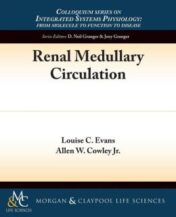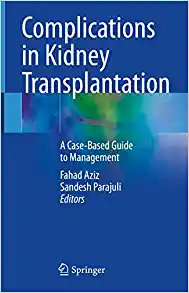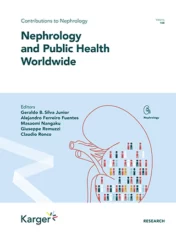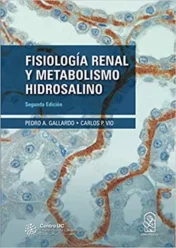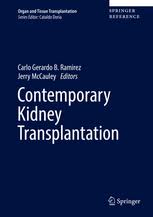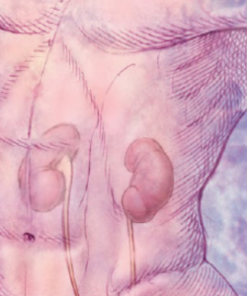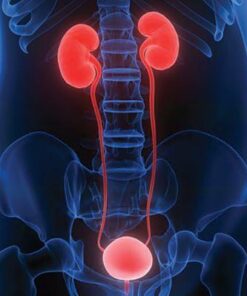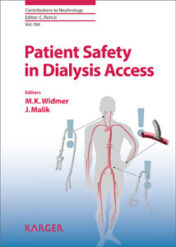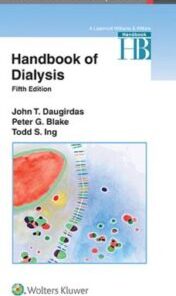Renal Medullary Circulation
The two kidneys of mammalian organisms receive around 25 % of the cardiac output at rest, of which only ~7 % is distributed to the renal medulla. Despite the low blood flow to the renal medulla, small changes in perfusion to the region can have profound effects on urine-concentrating ability and the excretion of sodium, which in turn affects the chronic regulation of body fluid volumes and arterial blood pressure. Importantly, we know that if blood flow to the renal medulla is not tightly regulated, sodium and water homeostasis is impaired and medullary hypoxia develops. The resultant injury inevitably reduces urine concentrating ability and leads to hypertension. This book will discuss the variety of mechanisms that mammalian organisms have developed to ensure that renal medullary blood flow and oxygen levels are precisely regulated. This book will focus on the unique anatomical arrangement of the medullary circulation, the functional roles of medullary blood flow, as well as the experimental techniques used to assess medullary blood flow and the insight that these studies have provided. The hormonal and non-hormonal control of medullary blood flow will be considered and finally the impact of reduced medullary blood flow on blood pressure is discussed.
Related Products
NEPHROLOGY BOOKS
NEPHROLOGY BOOKS
Robotic Surgery for Renal Cancer (Original PDF from Publisher)
NEPHROLOGY BOOKS
NEPHROLOGY BOOKS
NEPHROLOGY BOOKS
Handbook of Nephrology and Hypertension, 7th Edition (EPUB3)
NEPHROLOGY BOOKS
NEPHROLOGY BOOKS
Pediatric Nephrology, 8th Edition (Original PDF from Publisher)
Internal Medicine Videos
NEPHROLOGY BOOKS
Diagnostic Pathology: Kidney Diseases, 3rd Edition 2019 Original PDF
NEPHROLOGY BOOKS
NEPHROLOGY BOOKS
NEPHROLOGY BOOKS
NEPHROLOGY BOOKS
NEPHROLOGY BOOKS
Minimally Invasive Percutaneous Nephrolithotomy 2022 Original PDF
NEPHROLOGY BOOKS
NEPHROLOGY BOOKS
NEPHROLOGY BOOKS
American Society of Nephrology (ASN) Kidney Week 2021 CME VIDEOS
NEPHROLOGY BOOKS
NEPHROLOGY BOOKS
Handbook of Home Hemodialysis, 1st Edition High Quality PDF 2021
NEPHROLOGY BOOKS
NEPHROLOGY BOOKS
Kidney Transplantation Principles and Practice 2008 Original pdf
NEPHROLOGY BOOKS
Chronic Kidney Disease Diagnosis and Treatment 2020 Original pdf
NEPHROLOGY BOOKS
NEPHROLOGY BOOKS
Acute Kidney Injury and Regenerative Medicine 2020 Original pdf
NEPHROLOGY BOOKS
Diabetic Nephropathy Methods and Protocols 2020 Original pdf
NEPHROLOGY BOOKS
NEPHROLOGY BOOKS
NEPHROLOGY BOOKS
NEPHROLOGY BOOKS
Keynes & Aidley’s Nerve and Muscle, 5th Edition (Original PDF) 2020
NEPHROLOGY BOOKS
NEPHROLOGY BOOKS
NEPHROLOGY BOOKS
NEPHROLOGY BOOKS
NEPHROLOGY BOOKS
Harvard Comprehensive Review of Nephrology 2021 (CME Videos)
NEPHROLOGY BOOKS
Nephrocardiology, An Issue of Cardiology Clinics Original PDF
NEPHROLOGY BOOKS
Oxford Desk Reference Nephrology, 2nd Edition (Original PDF)
NEPHROLOGY BOOKS
NEPHROLOGY BOOKS
NEPHROLOGY BOOKS
Handbook of Critical Care Nephrology ePub+Converted PDF 2021
NEPHROLOGY BOOKS
NEPHROLOGY BOOKS
NEPHROLOGY BOOKS
NEPHROLOGY BOOKS
NEPHROLOGY BOOKS
NEPHROLOGY BOOKS
NEPHROLOGY BOOKS
NEPHROLOGY BOOKS
NEPHROLOGY BOOKS
NEPHROLOGY BOOKS
NEPHROLOGY BOOKS
Systemic Lupus Erythematosus, An Issue of Rheumatic Disease Clinics
NEPHROLOGY BOOKS
NEPHROLOGY BOOKS
New Insights into Glomerulonephritis : Pathogenesis and Treatment
NEPHROLOGY BOOKS
NEPHROLOGY BOOKS
NEPHROLOGY BOOKS
NEPHROLOGY BOOKS
NEPHROLOGY BOOKS
Hemolytic Uremic Syndrome: Symptoms, Treatment Options and Prognosis
NEPHROLOGY BOOKS
Pediatric Renal Transplantation: Protocols and Controversies
NEPHROLOGY BOOKS
Nephrology, An Issue of Primary Care: Clinics in Office Practice
NEPHROLOGY BOOKS
NEPHROLOGY BOOKS
Comprehensive Clinical Nephrology, 5th Edition (ORIGINAL PDF)
NEPHROLOGY BOOKS
NEPHROLOGY BOOKS
NEPHROLOGY BOOKS
Renal and Urologic Issues, An Issue of Clinics in Perinatology
NEPHROLOGY BOOKS

